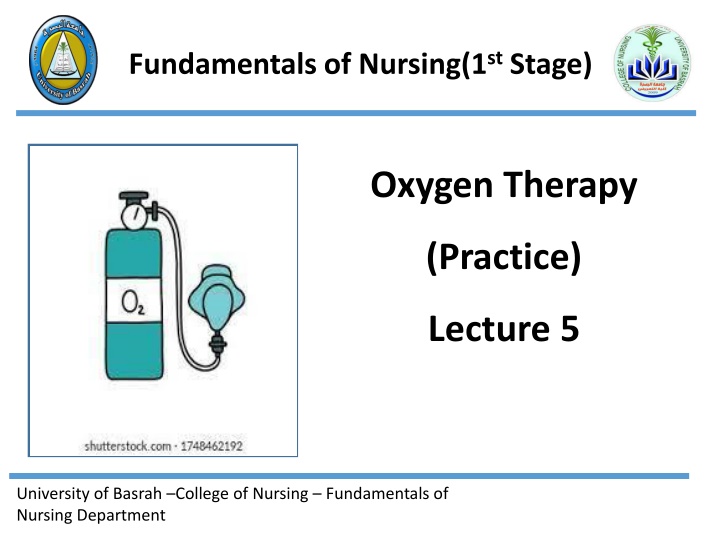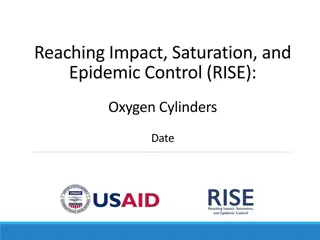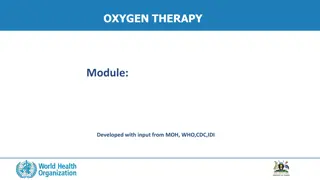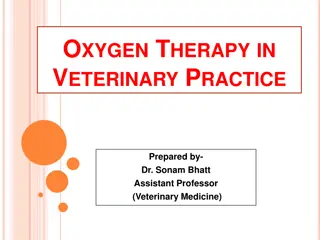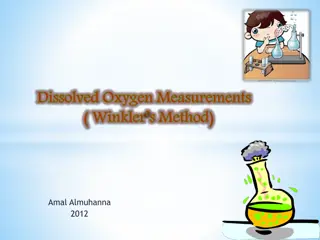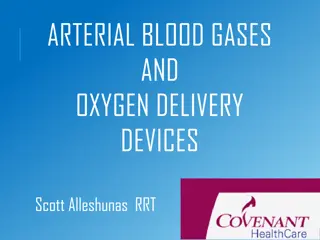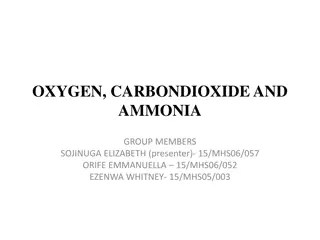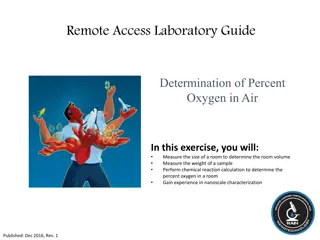Oxygen Therapy: Fundamentals and Practice Overview
Oxygen therapy is a vital intervention for individuals with respiratory conditions like COPD, pneumonia, asthma, and more. This practice involves administering supplemental oxygen to improve oxygen levels in the body, leading to enhanced energy levels and overall quality of life. Precautions and considerations in oxygen administration, including flow rates and delivery systems, play a crucial role in ensuring safe and effective therapy.
Download Presentation

Please find below an Image/Link to download the presentation.
The content on the website is provided AS IS for your information and personal use only. It may not be sold, licensed, or shared on other websites without obtaining consent from the author.If you encounter any issues during the download, it is possible that the publisher has removed the file from their server.
You are allowed to download the files provided on this website for personal or commercial use, subject to the condition that they are used lawfully. All files are the property of their respective owners.
The content on the website is provided AS IS for your information and personal use only. It may not be sold, licensed, or shared on other websites without obtaining consent from the author.
E N D
Presentation Transcript
Fundamentals of Nursing(1stStage) Oxygen Therapy (Practice) Lecture 5 University of Basrah College of Nursing Fundamentals of Nursing Department
Introduction Oxygen: a gas found in the air we breathe, is necessary for human life, which constitutes 21% of normal air , is a tasteless, odorless, and colorless gas. Some people with breathing disorders can t get enough oxygen naturally. They may need supplemental oxygen, or oxygen therapy. People who receive oxygen therapy often see improved energy levels, improved sleep, and an overall better quality of life.
Who Needs Oxygen Therapy? Oxygen therapy is prescribed for people who can t get enough oxygen on their own. This is often because of a lung condition that prevents the lungs from absorbing oxygen, including: COPD Pneumonia Asthma Dysplasia or underdeveloped lungs in newborns
Heart failure Cystic fibrosis Sleep apnea Lung disease Trauma to the respiratory system
Precautions for oxygen administration 1. Avoid open flames in the patient s room. 2. Place no smoking signs in conspicuous places in the patient s room or home . 3. Check to see that electrical equipment used in the room such as radios ,razors, and in suctioning equipment . 4. Avoid wearing and using synthetic fabrics that build up static electricity . 5. Avoid using oils in the area .oil can ignite spontaneously in the presence of oxygen .
Oxygen Flow Rate The flow rate of O2 , measured in liters per minute , determines the amount of O2 delivered to the patient. The rate varies depending on: Condition of the patient. Route of administration of the oxygen .
Oxygen delivery system Selection of the type of oxygen delivery system is based on the: Level of oxygen support that the patient needs. Severity of the hypoxia and the disease process Patient s age, level of health and orientation. Presence of an artificial airway. Whether the setting is in the hospital or the home. Type of home environment. Type of support and care given after discharge.
Oxygen delivery devices fall into one of two categories, high flow or low flow, depending on their ability to provide enough flow to match the patient s spontaneous minute volume. High-flow devices include venturi-mask, large-volume nebulizer, and blender masks. Low-flow devices include nasal cannula and simple mask, non rebreather, mask and partial rebreather masks.
1- Nasal cannula A nasal cannula is a simple, effective, and comfortable device for delivering oxygen to a patient. Oxygen is delivered via the cannula at a flow rate from 1 to 6 L/ min. Higher flow rates dry airway mucosa and do not increase the inspired oxygen concentration.
Advantages Safe and simple Easily tolerated Allowing patient to and drink eat, speak, Inexpensive and disposable
Disadvantages Drying dislodge to mucous easily membranes Can May breakdown cause skin irritation or Patient s affect breathing exact pattern will FiO2
2- Oxygen Mask Advantages Can help to provide humidified O2. Disadvantages levels of skin with eating increased irritate Interferes humidification may and talking
The simple face mask It is used for short-term oxygen therapy. It fits loosely and delivers oxygen concentrations from 40% to 60%. The mask is contraindicated for patients with carbon dioxide retention because it makes the retention worse. The percentage of oxygen delivered with a simple face mask depends on the liter flow and depth of respirations.
A plastic face mask with a reservoir bag The plastic face mask with a reservoir bag delivers 60% to 90% oxygen at appropriate flow rates. This oxygen mask maintains a high-concentration oxygen supply in the reservoir bag. Frequently inspect the bag to make sure that it is fully inflated. If it is not fully inflated, the patient breathes in large amounts of exhaled carbon dioxide.
Venturi mask is a cone-shaped high-flow device with entrainment ports of various sizes at the base of the mask. The entrainment ports adjust to permit regulation of FiO2 from 24% to 60%. This mask is useful because it delivers a more precise concentration of oxygen to a patient.
The face tent is a shield like device that fits under a patient s chin and sweeps around the face .It is used primarily for humidification and for oxygen only when a patient cannot or will not tolerate a tight-fitting mask. Because it is so close to a patient s face, there is no way to estimate how much oxygen is delivered to him or her.
Partial non rebreather mask Bag should Therefore enough Deliver 80% - 90% . always flow prevent remain rate collapse partially be of inflated. must high bag. to
Equipment Oxygen delivery device as ordered by health care provider Oxygen tubing (consider extension tubing) Humidifier, if indicated Sterile water for humidifier Oxygen source Oxygen flow meter Appropriate room signs
Nursing Diagnosis 1. Ineffective airway clearance 2. Impaired gas exchange 3. Ineffective breathing pattern Related factors are individualized based on patient s condition or needs.
Procedure 1- Perform hand hygiene. Apply face shield if risk of exposure to splashing mucus exists. 2- Identify patient using two identifiers (i.e., name and birthday or name and account number) according to agency policy. 3- Attach oxygen delivery device (e.g., cannula, mask) to oxygen tubing and attach end of tubing to humidified oxygen source adjusted to prescribed flow rate. 4- Apply oxygen device: A - Place the two tips of the cannula into patient s nares. If the tips are curved, they should point downward inside the nostrils. Then loop the cannula tubing up and over patient s ears. Adjust the lanyard so the cannula fits snugly but not too tightly. B- Apply a mask by placing it over patient s mouth and nose. Then bring the straps over patient s head and adjust to form a comfortable but tight seal.
5- Maintain sufficient slack on oxygen tubing and secure to patient s clothes. 6- Verify setting on flow meter and oxygen source for proper setup and prescribed flow rate. 7- Check cannula/mask every 8 hours. Keep humidification container filled at all times. 8- Perform hand hygiene.
